This article needs additional citations for verification .(July 2009) |
Walnut oil is oil extracted from walnuts, Juglans regia . The oil contains polyunsaturated fatty acids, monounsaturated fatty acids, and saturated fats. [1]
This article needs additional citations for verification .(July 2009) |
Walnut oil is oil extracted from walnuts, Juglans regia . The oil contains polyunsaturated fatty acids, monounsaturated fatty acids, and saturated fats. [1]
Walnut oil is composed largely of polyunsaturated fatty acids (72% of total fats), particularly alpha-linolenic acid (14%) and linoleic acid (58%), oleic acid (13%), and saturated fats (9%). [1]


Walnut oil is edible and is generally used less than other oils in food preparation, often due to high pricing. It is light-coloured and delicate in flavour and scent, with a nutty quality. [2] Although chefs sometimes use walnut oil for pan-frying, most avoid walnut oil for high-temperature cooking because heating tends to reduce the oil's flavour and produce a slight bitterness. Walnut oil is preferred in cold dishes such as salad dressings. [2]
Cold-pressed walnut oil is typically more expensive due to the loss of a higher percentage of the oil. Refined walnut oil is expeller-pressed and saturated with solvent to extract the highest percentage of oil available in the nut meat. The solvents are subsequently eliminated by heating the mixture to around 400 °F (200 °C). Both methods produce food-grade culinary oils. Walnut oil, like all nut, seed and vegetable oils can turn rancid.
Over 99% of walnut oil sold in the US is produced in California. [3]
Walnut oil was one of the most important oils used by Renaissance painters. Its short drying time and lack of yellow tint make it a good oil paint base thinner and brush cleaner.
Some woodworkers favour walnut oil as a finish for implements that will come in contact with food, such as wooden bowls, because of its safety. Rancidity is not an issue because walnut oil dries when applied to wood in a thin coating. People who mix oil and wax to formulate wood finishes value walnut oil as an ingredient because of the edibility of both ingredients. The oil typically is combined with beeswax in a mixture of 1/3 oil to 2/3 beeswax. [4]

A triglyceride is an ester derived from glycerol and three fatty acids. Triglycerides are the main constituents of body fat in humans and other vertebrates, as well as vegetable fat. They are also present in the blood to enable the bidirectional transference of adipose fat and blood glucose from the liver, and are a major component of human skin oils.

Vegetable oils, or vegetable fats, are oils extracted from seeds or from other parts of fruits. Like animal fats, vegetable fats are mixtures of triglycerides. Soybean oil, grape seed oil, and cocoa butter are examples of seed oils, or fats from seeds. Olive oil, palm oil, and rice bran oil are examples of fats from other parts of fruits. In common usage, vegetable oil may refer exclusively to vegetable fats which are liquid at room temperature. Vegetable oils are usually edible.
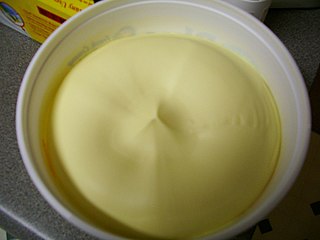
Margarine is a spread used for flavoring, baking, and cooking. It is most often used as a substitute for butter. Although originally made from animal fats, most margarine consumed today is made from vegetable oil. The spread was originally named oleomargarine from Latin for oleum and Greek margarite. The name was later shortened to margarine.
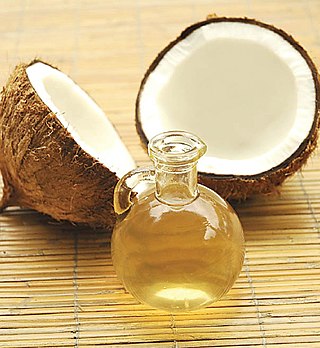
Coconut oil is an edible oil derived from the kernels, meat, and milk of the coconut palm fruit. Coconut oil is a white solid fat below around 25 °C (77 °F), and a clear thin liquid oil in warmer climates. Unrefined varieties have a distinct coconut aroma. Coconut oil is used as a food oil, and in industrial applications for cosmetics and detergent production. The oil is rich in medium-chain fatty acids.

Linseed oil, also known as flaxseed oil or flax oil, is a colourless to yellowish oil obtained from the dried, ripened seeds of the flax plant. The oil is obtained by pressing, sometimes followed by solvent extraction.

Hemp oil is oil obtained by pressing hemp seeds. Cold pressed, unrefined hemp oil is dark to clear light green in color, with a nutty flavor. The darker the color, the grassier the flavour. It should not be confused with hash oil, a tetrahydrocannabinol-containing oil made from the Cannabis flower.
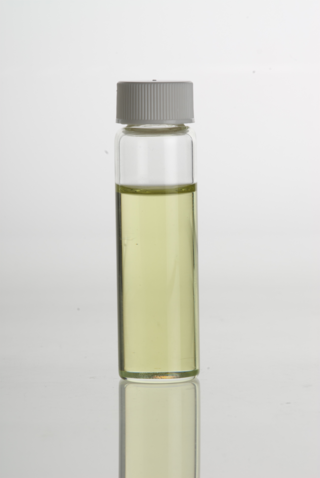
Grape seed oil is a vegetable oil derived from the seeds of grapes. A by-product of the winemaking industry, it is typically used for edible applications.
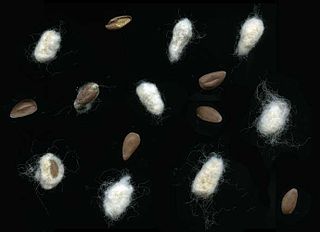
Cottonseed oil is cooking oil from the seeds of cotton plants of various species, mainly Gossypium hirsutum and Gossypium herbaceum, that are grown for cotton fiber, animal feed, and oil.

A drying oil is an oil that hardens to a tough, solid film after a period of exposure to air, at room temperature. The oil hardens through a chemical reaction in which the components crosslink by the action of oxygen. Drying oils are a key component of oil paint and some varnishes. Some commonly used drying oils include linseed oil, tung oil, poppy seed oil, perilla oil, and walnut oil. Their use has declined over the past several decades, as they have been replaced by alkyd resins and other binders.
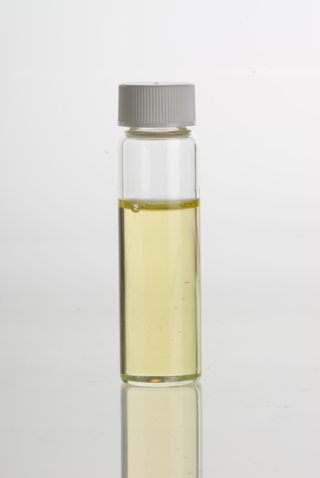
Sesame oil is an edible vegetable oil derived from sesame seeds. The oil is one of the earliest-known crop-based oils. Worldwide mass modern production is limited due to the inefficient manual harvesting process required to extract the oil. Oil made from raw seeds, which may or may not be cold-pressed, is used as a cooking oil. Oil made from toasted seeds is used for its distinctive nutty aroma and taste, although it may be unsuitable for frying, which makes it taste burnt and bitter.
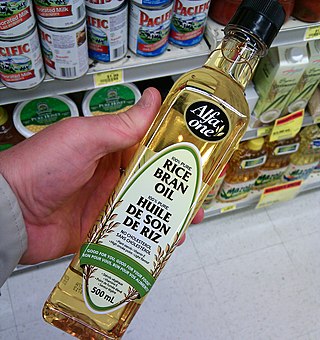
Rice bran oil is the oil extracted from the hard outer brown layer of rice called bran. It is known for its high smoke point of 232 °C (450 °F) and mild flavor, making it suitable for high-temperature cooking methods such as stir frying and deep frying. It is popular as a cooking oil in East Asia, the Indian subcontinent, and Southeast Asia including India, Nepal, Bangladesh, Indonesia, Japan, Southern China and Malaysia.
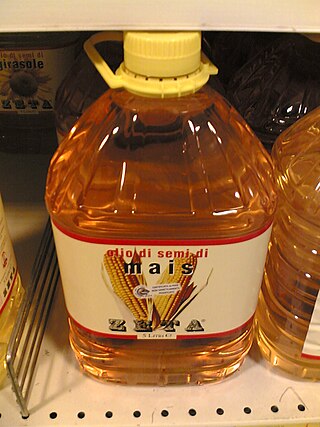
Corn oil or maize oil (British) is oil extracted from the germ of corn (maize). Its main use is in cooking, where its high smoke point makes refined corn oil a valuable frying oil. It is also a key ingredient in some margarines. Corn oil is generally less expensive than most other types of vegetable oils.

Soybean oil is a vegetable oil extracted from the seeds of the soybean. It is one of the most widely consumed cooking oils and the second most consumed vegetable oil. As a drying oil, processed soybean oil is also used as a base for printing inks and oil paints.

Sunflower oil is the non-volatile oil pressed from the seeds of the sunflower. Sunflower oil is commonly used in food as a frying oil, and in cosmetic formulations as an emollient.

In biochemistry and nutrition, a polyunsaturated fat is a fat that contains a polyunsaturated fatty acid, which is a subclass of fatty acid characterized by a backbone with two or more carbon–carbon double bonds. Some polyunsaturated fatty acids are essentials. Polyunsaturated fatty acids are precursors to and are derived from polyunsaturated fats, which include drying oils.

Pecan oil is an edible pressed oil extracted from the pecan nut. Pecan oil is neutral in flavor and takes on the flavor of whatever seasoning is being used with it. Pecan oil contains 9.5% saturated fat, which is less than in olive oil (13.5%), peanut oil (16.90%) or corn oil (12.70%). It is also used as a massage oil and in aromatherapy applications.

Pistachio oil is a pressed oil, extracted from the fruit of Pistacia vera, the pistachio nut.
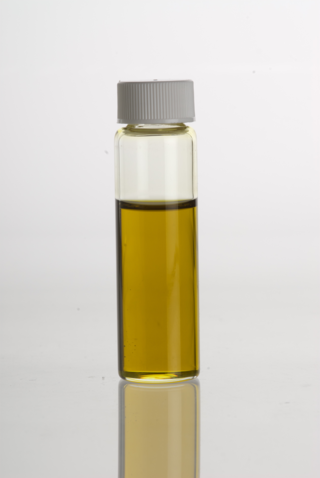
Avocado oil is an edible oil extracted from the pulp of avocados, the fruit of Persea americana. It is used as an edible oil both raw and for cooking, where it is noted for its high smoke point. It is also used for lubrication and in cosmetics.
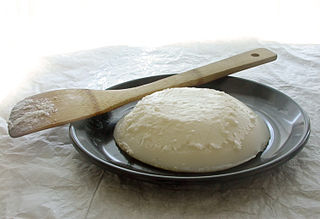
Lard is a semi-solid white fat product obtained by rendering the fatty tissue of a pig. It is distinguished from tallow, a similar product derived from fat of cattle or sheep.

Cooking oil is a plant or animal liquid fat used in frying, baking, and other types of cooking. Oil allows higher cooking temperatures than water, making cooking faster and more flavorful, while likewise distributing heat, reducing burning and uneven cooking. It sometimes imparts its own flavor. Cooking oil is also used in food preparation and flavoring not involving heat, such as salad dressings and bread dips.